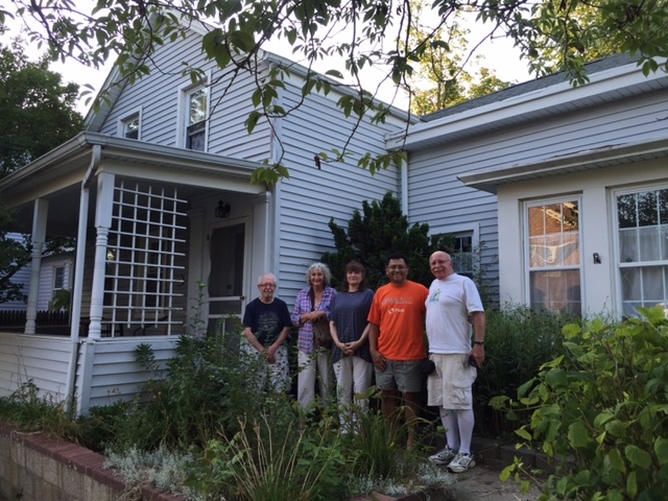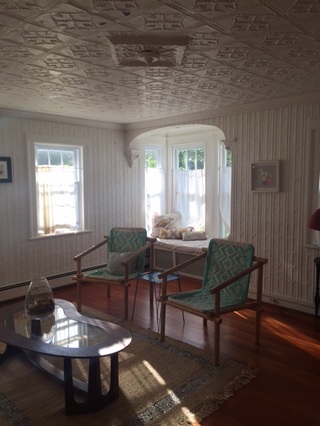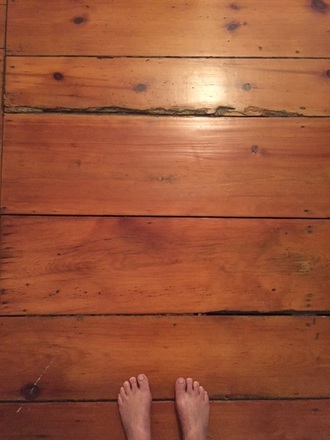Even the Brooklyn Boy Needs a Break: Walt Whitman’s Summer Fling in Greenport
By Karen Karbiener
Walt Whitman is the world’s first New Yorker. Declaring himself as both a “Brooklyn Boy” and a “Manhattanese” at the same time Emerson described the Big Apple as a “sucked orange,” Poe denounced its noise and too-rapid development, and Thoreau felt “sick ever since I came here,” Whitman celebrated the urban roots of Leaves of Grass in many of his greatest poems. “Walt Whitman, a kosmos, of Manhattan the son” named the city his spiritual forefather in “Song of Myself,” and “Crossing Brooklyn Ferry” is just about everyone’s pick for the greatest New York poem ever written. “Proud and passionate city! mettlesome, mad, extravagant city!” he sings in “City of Ships.” “I chant and celebrate all that is yours.”
But 165 years before this blog post on summer city getaways was scribed for Gotham readers, Walt published his own versions of such pieces in the New York Evening Post and the New York Sunday Dispatch. “Swarming and multitudinous as the population of the city still is, there are many thousands of its usual inhabitants now absent in the country,” he wrote in 1851. “Having neither the funds nor disposition to pass my little term of ruralizing at the fashionable baths, or watering places, I am staying awhile down here at Greenport, the eastern point of the Long Island Railroad.”
One of the few certainties about the mysterious “seed-time” of Leaves of Grass -- Whitman-speak for the decade preceding its publication in 1855 -- was his attraction to the village of Greenport on the north fork of Long Island. Records show that Whitman visited the area several times from 1846 on. Not only did he document these experiences in serial articles, he submitted a real estate advertisement in the Sag Harbor Corrector for “15 Acres of Land Wanted” in the area. This ad, recently discovered by historical researcher and dedicated Whitmaniac Margaret Guardi, suggests that the poet of New York may even have wanted to live in the vicinity of Greenport. The ad ran thirty-nine times from August 2 to December 16, 1848:
15 ACRES OF LAND WANTED-- Any person in any of the eastern towns of Long Island, having 12 or 15 acres of Land (with a little woodland, if possible, though that is not absolutely requisite) may hear of a purchaser, by addressing a note through the Post Office, to the undersigned. If near the water it will be considered a great advantage. No buildings wanted on the land, and price to be not more than $16 an acre.
W. Whitman, Jr.
71 Prince st., Brooklyn
The Long Island Railroad’s new line out to Greenport, completed in 1844, undoubtedly influenced Whitman’s decision to explore the area. So did his sister Mary Elizabeth’s relocation from the Brooklyn family home after her marriage to Ansel Van Nostrand in 1840. A center for America’s whaling industry through the first half of the 19th century, Greenport was a great location for ship builders such as Ansel. About 25 vessels used it as a home port during his time, and the income they generated developed the town into a busy village with fine hotels, stores, saloons, and 2,000 residents by the 1860s. The couple thrived there, raising five children and purchasing a cape on South Street in 1850.
A few months ago, Margaret excitedly told me that Whitman’s sister’s house was posted on Airbnb. Here was an opportunity to do more than visit, but to live in a genuine Whitman house! It didn’t take long to round up a few loyal Whitmaniacs to rent the house. Whitman collector Ed Centeno, his partner Ken Smith and their dog Pip, Whitman camerado Frank Gagliardi, my daughter, and myself agreed on four days in August for our adventure. Margaret would be able to visit for us for a day, and we would also connect with important local historians Gale Horton (curator of the Stirling Historical Society in Greenport) and John Holzapfel, President of Oysterponds Historical Society.
And so this blog entry is being written from the very house in which Walt himself probably wrote his serial articles about his Greenport getaways.
Whitman pilgrims Ken Smith (left), Ed Centeno and Frank Gagliardi (fourth and fifth from left) join historians Gail Horton and Margaret Guardi in front of 218 South Street, Greenport.
There are only a few places out there where you can “lean and loafe” where Walt did as he worked on what would eventually be regarded as America’s cultural declaration of independence, Leaves of Grass. As inspirational as the Whitman Birthplace in Huntington, Long Island is, Walt never wrote a poem here; his family sold this property and moved to booming Brooklyn around his fourth birthday. The house in Camden, New Jersey in which Whitman spent his final years was purchased in 1874, long after the poet had published the revolutionary first edition of Leaves of Grass in 1855. To absorb the atmosphere in which this breakthrough collection of twelve poems was written, most pilgrims trek to 99 Ryerson Street on the edge of Fort Greene. Walt lived and wrote in this wood-frame house during the months in which he was putting finishing touches on the Leaves, and it’s considered the single Whitman house still standing from his New York years.
But that depends upon your definition of New York. Walt’s stretched out to the North Fork, where he spent several happy summers during the time of his life still most obscure to Whitman scholars. His base was his favorite sister’s house, though it’s questionable that he would have always slept here. Mary and Ansel had four children and five bedrooms and it is possible that Walt might have shared a bed with their only son, George. The second oldest of eight Whitman children, Walt had never had a room of his own, and for many years slept alongside his youngest brother Eddy. Ironically enough, the fiercely independent-minded poet didn’t have a sense of personal space.
But Walt does write about “boarding round” on the East End and even gives advice to the area’s proprietors. “We folks from the region of pavements are too much used to pianos, fashionable carpets, mahogany chairs, to be seriously impressed by them when we go in the country,” he writes in the Post on June 27, 1851. “Only let us have plenty of cleanliness, water by wholesale, and abundance of the rich fresh fare of your country dairy, and country gardens.” And in the Stirling Historical Society in the heart of Greenport -- a must-see for history buffs, thoughtfully curated by long-time Greenport resident Gail Horton -- signage announces Whitman as one of the many illustrious guests of the Clark House.
Even if he didn’t actually sleep here, Walt probably came to South Street cape to relax, regroup, and write. It was certainly a better place to do all three than the Clark House, the “hub of all social activity” where “the captains and the officers of the whaling ships met and had their banquets and their dances” (Brooklyn Daily Eagle, April 18, 1909). Walt’s limited budget ensured that he would be sharing his room (and probably his bed) with at least a few other patrons of the Clark House. His writing may well have been inspired by the old inn, where strangers shared stories in the busy tavern and slept side by side upstairs; but Walt may have had trouble finding a physical as well as a mental space for his literary labors here.
Sketchy "rules" found in the dining quarters of the Webb House, on the campus of the Oysterponds Historical Society. An eighteenth century structure once used as an inn in Greenport, Webb House provides a living example of what the Clark House might have been like when Walt allegedly stayed there.
Not true of 218 South Street. Even in 2016, the construction, placement, and temperament of this house make it a great writer’s lair. These very lines, in fact, roll smoothly out from the spacious first floor bedroom. It’s about midnight and both front windows are open. A cool summer breeze wafts the white curtains. The porch just outside is covered, and further protected by leafy boughs and a trellice. The lone street light illuminates an empty sidewalk. It’s hushed but not quiet, and a chorus of crickets rises over the hum of the marina not too far away. A couple strolls in the middle of the street, voices softened by the night air, one of them swinging her sandals.
The house is simple and pleasing, and generous even for its size. My daughter Annike and I are sleeping in what must have been Mary and Ansel’s room; it’s big enough for a king-sized bed, two doorways, three windows and two cleverly designed (and probably more modern) back-to-back closets. Outside our door, the living room spreads out invitingly; its large plate-glass windows several will bring brilliant morning sun to the padded bench in the picture window. Tin walls and ceilings are painted white and resemble the interior of the 19th century Methodist church in Groton, Vermont that I visited a week ago. They add a playful feminine grace to the house, which is further enhanced by our host Lora Sappenfeld’s choice of soft textures and muted colors.
The living room on a sunny August morning. Note the intricately patterned tin ceiling and walls, as well as the picture window.
I don’t see Walt in either of these rooms. But I do see him in the generous, wainscoted kitchen in the back -— perhaps even at the broken-in farm table extending in front of the windows. I can see him in the no-fuss back yard, observing the summer grass under the trees, poking around in the tool shed.
And I hear him walking across the wide boards of the second floor hallway. “If you want me again look for me under your bootsoles,” Walt writes near the end of “Song of Myself”; and it’s here that I find the feature of the house that best represents my idea of the man and poet. Such broad planking, rarely seen nowadays, makes use of big, old-growth trees. Perhaps he paced these floorboards (as was his wont) while writing those pieces for the Dispatch -- or working out the aforementioned line from his greatest poem.
My feet on Walt’s floorboards, upstairs at Mary and Ansel’s.
So if it was so perfect, why didn’t he stay? Considering that he had no family or home of his own and no regular employment after he was fired from the Eagle in January 1848, why did he decide to return to Brooklyn and pull the ad from the Corrector? The same “blogs” he might have written in this space indicate why. “I know from the frequent bent of my own feelings, that yearning for the freshness and quiet of the country -- that love of freedom from the ligatures and ceremonies of a life in town,” he considers in one of the “Letters From a Travelling Bachelor” (New York Sunday Dispatch, October 28, 1849). “But to be born and "brought up" in an out of the way country place, and so continue there through all the stages of middle life -- and eat and drink there only, and "dress up" of a Sunday and go to church there -- and at last die and be buried there -- is that an enviable lot in life? No, it is not.” Whitman realizes that he is writing against the “popular view” that the solitude of country living develops “virtuous conduct, and intellectual and scientific improvement” -- and yet, he insists he is sharing “the truth.”
In a show of true New York snobbery, Whitman denounces the provincialism and lack of “restlessness” in the East End residents he has encountered, as well as their disinterest in culture. “I am aware that these people might be very intelligent, and very manly and womanly, without ever having seen a play or a piano --and therefore I only mention that as a specimen of their primitiveness. But the vegetating forever in one little spot of this wide and beautiful world -- the absence of books -- the getting set in the narrow notions of the locality where they live—serve to dwarf and distort much of the goodly elements of their own nature; and increase the same rude effects to the third and fourth generation.” He notes that even the physical advantages of country life are “counterbalanced by evils in other points” such as a curtailed youth and the bodily exhaustion that comes from hard work. His comments on the surprisingly unhealthy diet of most country folk -— “pork and grease, doughy bread, and other indigestible dishes” -— foreshadow his advice in “Manly Health and Training,” a recently discovered series of articles published in the New York Atlas of 1858.
But there are signs that the dandified, penny daily hack Walter Whitman Jr. was in the process of becoming Walt Whitman, all-embracing poet of democracy. A long composition published in the New York Evening Post on June 28, 1851 highlights a connection he made despite great differences of age and point of origin. At first remarking incredulously on an old resident’s bedraggled appearance (“That hat! It was a hat which I am sorry now I did not buy up and present to one of the Broadway ‘merchants’ in that line, or to the eating house near the Fulton ferry, whose window has such amusing curiosities”), the fashion forward New Yorker walks a mile with him and listens to his tragic tale: the man’s two sons were lost at sea many years ago, and the family savings with them. The men share more personal stories and a meal before Whitman returns to his quarters. In the end, Whitman has clearly and willingly taken on a role as surrogate son, and come that much more down to earth -- and his beloved leaves of grass.
Why do city folk need a country summer escape, but country folk don’t need the city? Whitman suggests that we’re “sent away by hot weather”, "the prevailing custom," -- and perhaps most significantly, by the “desire for change” (New York Evening Post, June 27, 1851). City folk aren’t necessarily city folk because they are drawn to cities. Perhaps what really defines city folk is that we need to see change, to experience variety. Whitman may have gotten key inspiration for the Leaves from his experiences here in Greenport and perhaps even imagined himself living out here, but he ultimately traded the picturesque prose of a country retreat for the poetry of an urban existence.
Keep your words, O Nature, and the quiet places by the woods;
Keep your fields of clover and timothy, and your corn-fields and orchards;
Keep the blossoming buckwheat fields, where the Ninth-month bees hum;
Give me faces and streets! Give me these phantoms incessant and endless
along the trottoirs!
Give me interminable eyes! Give me women! Give me comrades and lovers by
the thousand!
Let me see new ones every day! Let me hold new ones by the hand every day!
Give me such shows! Give me the streets of Manhattan!...
Manhattan faces and eyes forever for me.
(from “Give Me the Splendid Silent Sun”)
Karen Karbiener teaches at New York University and is a public scholar of Walt Whitman. She organizes Whitman-centric events in New York City, including the annual "Song of Myself" Marathon. For more information, write songofmyselfmarathon@gmail.com.



